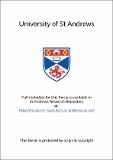Files in this item
Studies of excitotoxicity in cerebellar granule neurons
Item metadata
| dc.contributor.advisor | Griffiths, Roger | en |
| dc.contributor.author | Sinclair, Colin James | en |
| dc.coverage.spatial | xiv, 295 p : ill. (some col.) 30 cm. | en |
| dc.date.accessioned | 2021-04-08T09:04:15Z | |
| dc.date.available | 2021-04-08T09:04:15Z | |
| dc.date.issued | 2004 | |
| dc.identifier.uri | https://hdl.handle.net/10023/22007 | |
| dc.description.abstract | Excitotoxicity is defined as neuronal cell death caused by hyperactivation of ionotropic glutamate receptors (namely NMDA-, AMPA- and KA-receptors). The excitotoxic potential of a novel AMPA receptor subtype-selective agonist, (S)-CPW 399 was investigated, using 7 div cultured cerebellar granule neurons as an in vitro model system of glutamatergic neurons. The results demonstrate that (S)-CPW 399 induces excitotoxicity by stimulating Ca²⁺ influx through Ca²⁺-permeable AMPA receptors, with no other coincident mechanism of Ca²⁺ infux being involved. Uniquely among AMPA receptor-selective agonists, (S)-CPW 399 appeared to have the ability to induce AMPA receptor-mediated functional responses without the need for blockade of AMPA receptor desensitisation. These results suggest that (S)-CPW 399 may be used as a pharmacological tool to aid in the investigation of the role of AMPA receptors in excitotoxicity and their molecular mechanisms of desensitisation. In a supporting study, it was shown that classic desensitising AMPA receptorselective agonists produced similar results to that seen for (S)-CPW 399 under an identical experimental paradigm only when AMPA receptor desensitisation was inhibited by cyclothiazide. Previously published data suggest that the normal physiological temporal profile of c-fos mRNA expression following stimulation of cells is altered following excitotoxic insult. More precisely, the transient expression observed under non-excitotoxic conditions is replaced by delayed, elevated and sustained expression under excitotoxic conditions. As a result, it has been postulated that ratiometric analysis of c-fos mRNA expression at selected timepoints following stimulation could provide a mechanistically relevant in vitro predictive test for excitotoxicity. This was assessed in an industrial context using real time RT-PCR for mRNA quantitation following exposure of granule cells to high and low concentrations of excitotoxic and non.- excitotoxic compounds. The results suggest that the proposed test requires further modification and validation to achieve a robust, reliable large-scale screening test for excitotoxic potential of compounds. | en |
| dc.language.iso | en | en |
| dc.publisher | University of St Andrews | en |
| dc.subject.lcc | QP364.7S5 | |
| dc.subject.lcsh | Neurotransmitter receptors | en |
| dc.subject.lcsh | Neurotoxic agents--Mechanism of action | en |
| dc.title | Studies of excitotoxicity in cerebellar granule neurons | en |
| dc.type | Thesis | en |
| dc.type.qualificationlevel | Doctoral | en |
| dc.type.qualificationname | PhD Doctor of Philosopy | en |
| dc.publisher.institution | The University of St Andrews | en |
This item appears in the following Collection(s)
Items in the St Andrews Research Repository are protected by copyright, with all rights reserved, unless otherwise indicated.

